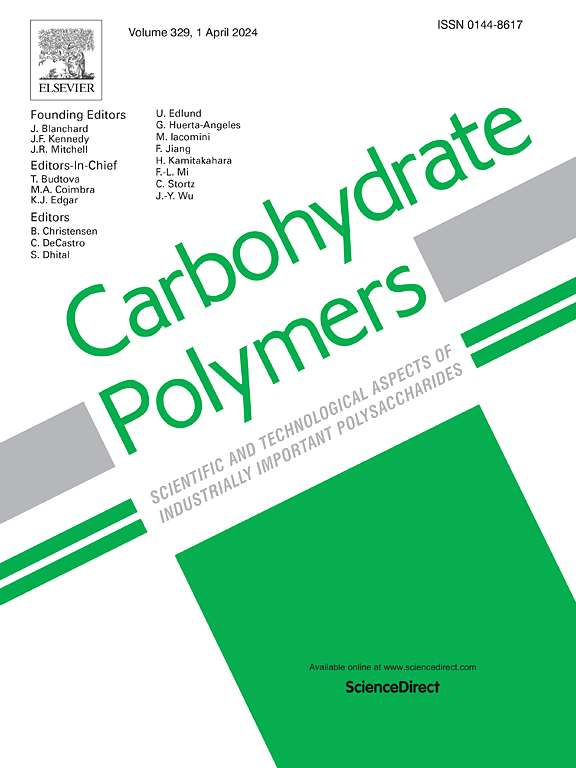Enhanced wound healing with a bilayered multifunctional quaternized chitosan-dextran-curcumin construct
IF 12.5
1区 化学
Q1 CHEMISTRY, APPLIED
引用次数: 0
Abstract
This study introduces a novel bilayer wound dressing that integrates a quaternized chitosan-polyacrylic acid (QCs-PAA) sponge as the top layer with electrospun nanofibers containing curcumin as the bottom layer. For the first time, QCs and PAA were combined in an 80:20 ratio through freeze-drying to form a porous sponge layer with ideal structural properties, including 83 ± 6 % porosity and pore diameters of 290 ± 12.5 μm. For the bottom layer, five groups of nanofibers containing PAA, dextran, and curcumin were electrospun onto the porous sponge. All wound dressings were non-toxic and exhibited exceptional antibacterial activity against S. aureus and E. coli. All groups, particularly the QP/PD0.25Cur bilayer dressing, showed significant HaCaT cell adhesion. Angiogenesis assays confirmed a remarkable increase in blood vessel number and thickness in samples containing 0.25 w/w% curcumin, with vascular density increasing from 0.32 in the single-layer sponge to 0.54 in the QP/PD0.25Cur sample, representing a 68 % enhancement. In vivo studies demonstrated that within 14 days, wound healing was accelerated with the QP/PD0.25Cur bilayer dressing, achieving 96 % closure compared to other groups. The findings revealed that all fabricated bilayer sponge-nanofiber wound dressings, particularly the 0.25 w/w% curcumin sample, can be a suitable candidate for wound management.

增强伤口愈合与多层多功能季铵化壳聚糖-葡聚糖-姜黄素结构。
本研究介绍了一种新型的双层伤口敷料,该敷料以季铵盐化壳聚糖-聚丙烯酸(QCs-PAA)海绵为表层,以含有姜黄素的电纺纳米纤维为底层。通过冷冻干燥,首次将qc和PAA以80:20的比例结合,形成具有理想结构性能的多孔海绵层,孔隙率为83±6%,孔径为290±12.5 μm。在底层,五组含有聚丙烯酸、葡聚糖和姜黄素的纳米纤维被电纺丝到多孔海绵上。所有伤口敷料均无毒,并表现出对金黄色葡萄球菌和大肠杆菌的抗菌活性。所有组,特别是QP/PD0.25Cur双层敷料,均显示显著的HaCaT细胞粘附。血管生成实验证实,在含有0.25 w/w%姜黄素的样品中,血管数量和厚度显著增加,血管密度从单层海绵的0.32增加到QP/PD0.25Cur样品的0.54,增加了68%。体内研究表明,在14天内,QP/ pd0.25双分子层敷料加速了伤口愈合,与其他组相比,愈合率达到96%。研究结果表明,所有制备的双层海绵纳米纤维伤口敷料,特别是0.25 w/w%姜黄素样品,都可以成为伤口管理的合适候选材料。
本文章由计算机程序翻译,如有差异,请以英文原文为准。
求助全文
约1分钟内获得全文
求助全文
来源期刊

Carbohydrate Polymers
化学-高分子科学
CiteScore
22.40
自引率
8.00%
发文量
1286
审稿时长
47 days
期刊介绍:
Carbohydrate Polymers stands as a prominent journal in the glycoscience field, dedicated to exploring and harnessing the potential of polysaccharides with applications spanning bioenergy, bioplastics, biomaterials, biorefining, chemistry, drug delivery, food, health, nanotechnology, packaging, paper, pharmaceuticals, medicine, oil recovery, textiles, tissue engineering, wood, and various aspects of glycoscience.
The journal emphasizes the central role of well-characterized carbohydrate polymers, highlighting their significance as the primary focus rather than a peripheral topic. Each paper must prominently feature at least one named carbohydrate polymer, evident in both citation and title, with a commitment to innovative research that advances scientific knowledge.
 求助内容:
求助内容: 应助结果提醒方式:
应助结果提醒方式:


